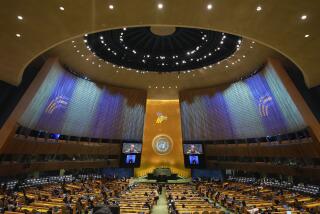Nuke-Free World--a Practical Vision
The Reykjavik summit collapsed because President Reagan refused to sacrifice his vision of a defense in the sky for an agreement to reduce nuclear arms on Earth.
The United States surely would have been more secure had the Soviets cut half their missiles and bombers within five years in return for a similar cut in our own strategic forces and a mutual promise to confine research on the Strategic Defense Initiative to the laboratory for 10 years. Moreover, the Soviets moved to the President’s position by agreeing to the principle urged on them to get rid of all means of delivering nuclear weapons in 10 years.
The President’s vision of a world without nuclear weapons that would be protected by SDI has inspired considerable skepticism. American politicians, generals and strategists term the idea “just propaganda.” The hard-line President, they say, was merely preempting for himself and his party the public longing for an end to nuclear terror. The skepticism is justified. It is hard to believe that a President with such great faith in technology and so little trust in the Soviets means what he says. But his vision of a nuclear-free world is not wrong.
The conventional wisdom is that we are doomed to live forever with nuclear weapons because “the bomb cannot be uninvented” and the world would be “unstable” if we did not live under instant nuclear terror. Somebody could cheat.
The overwhelming threat facing the United States is Soviet nuclear weapons. Because of the destructiveness of even one such weapon, national security is not possible until the Soviet stockpile virtually is eliminated. The issue is not whether such a world would be absolutely safe--it would not be--but whether the risks of real disarmament would be less than the present risks and the horrendous world of Buck Rogers weapons on the horizon. However, it could be a far safer world if the President’s vision were broadened to deal with the practical objections:
We need thousands of nuclear weapons to balance Soviet conventional superiority in Europe. The way to deal with that problem is to negotiate mutual balance reductions in Europe, with Europeans taking greater responsibility for their own defense by conventional means. The United States could help by negotiating the denuclearization, troop and tank reductions and a generally lower state of mobilization on both sides.
Europe cannot rely on nuclear threats for security, for the threats guarantee an arms race and alarm the population. The President’s vision requires the United States to come to terms with reality: Nuclear weapons are not weapons in either a military or political sense, for they cannot be used without destroying what they are intended to defend. Their use is irrational, and threats to use them therefore are incredible. If, after the years of hullabaloo about the intermediate-range missiles in Europe, both sides at Reykjavik appeared willing to take all of them out, why should significant agreements to reduce conventional arms be out of reach? After nuclear weapons have been cut 50%, further reductions should be tied to progress in conventional arms reduction.
Someone could hide a bomb. That is true now. A nation with borders porous enough to let billions of dollars of illegal drugs slip through each year would be vulnerable to nuclear weapons smuggled in a packing case, even if the Astrodome in the sky worked perfectly. But there is a difference between a world of 60,000 nuclear weapons or even a world of 30,000, and a one in which a few weapons might escape the verification system that would surely be part of any agreement for radical reduction. It literally is the difference between life and death for the nation, and probably for the planet.
The whole purpose of arms reduction is to create new incentives that will transform the political relationship between the superpowers. The Soviets would have a powerful stake in maintaining a far-reaching agreement that was fair to both sides, for it would mean that they were no longer minutes away from total devastation. Of course a madman could come to power anywhere, but concealing a few bombs for blackmail would be an unpromising strategy for the Soviets. They could not be sure, indeed, might well assume, that the United States had cheated, too.
The knowledge for making bombs would remain, along with the threat of retribution. Zero stockpiles would, of course, be premised on the other nuclear powers joining in. Real disarmament would create the best possible political climate for discouraging non-nuclear powers from making bombs.
In a world free of nuclear weapons the security problem would look different. The mutual fear of the superpowers would dissolve only when they reestablish an alliance, not against the Martians, as Reagan suggested to Gorbachev at Geneva, but to take on the specter of environmental pollution, mismanagement of planetary resources and a deteriorating world economy, which threatens the two nations along with everybody else.
Against the clear advantages of a world without nuclear stockpiles, the hypothetical nightmares should not paralyze us to further drift to nuclear war but should challenge our imagination to think of incentives and non-nuclear deterrents to keep the peace. In a nuclear-disarmed world a truly non-nuclear version of SDI might make sense. That would be the only situation in which it would.
More to Read
Sign up for Essential California
The most important California stories and recommendations in your inbox every morning.
You may occasionally receive promotional content from the Los Angeles Times.










